Metals Economics Group Pipeline Activity Index (PAI) increased for the second consecutive month to reach a four-month high in September, driven by impressive numbers of significant drill results and a jump in initial gold resource announcements. In October, however, the increased number of significant drill results was not enough to outweigh poor financing conditions, dropping the PAI slightly.
The industry’s aggregate market cap plummeted during a rough September, falling below $1.8 trillion for the first time since August 2010. Market caps recovered to $1.96 trillion in October—still below 2011’s year-to-date monthly average of $2.23 trillion.
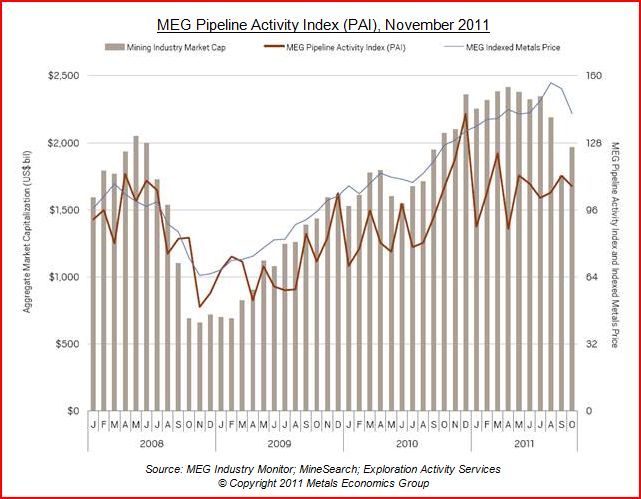
Despite softening metals prices, the number of significant drill results increased in the September-October period. The impact of recently fluctuating metals prices and ongoing market turmoil on explorers—especially juniors—will likely play out during the remainder of 2011 and into early 2012. North America, Latin America, and Australia-Pacific together accounted for 77% of the significant gold results and 86% of the base metals results in September-October—up from 68% and 72% respectively for the corresponding period in 2010.
The number of initial resources announced in September matched 2011’s one-month high. Gold led and September’s numbers presented the second-highest one-month total since 2008, which is not surprising given the steady rise in gold exploration seen throughout most of 2010 and 2011. Latin American projects accounted for four of the top five initial gold resources and two of the top five initial base metals resources, giving the region 57% of the overall in-situ value of resources announced in September-October.
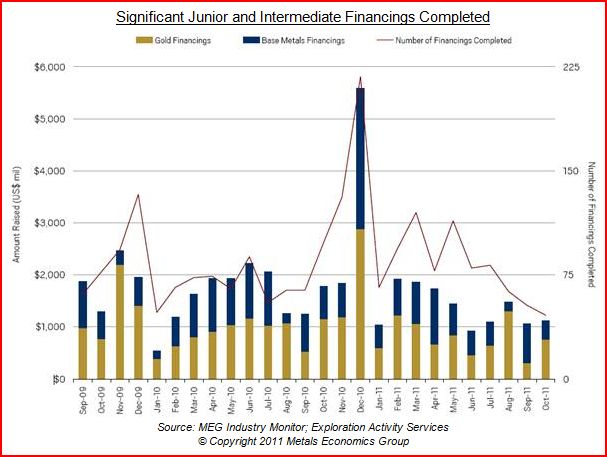
The number of significant financings (US$2 million minimum) completed by junior and intermediate companies slid for the third consecutive month in October, as already-volatile markets continued to be hampered by global growth concerns and sovereign debt problems. With $1.07 billion raised, September-October marks the lowest total for gold financings since January-February 2010. In addition, the number of base metals financings marks the lowest total for this group since May-June 2009.
From the report entitled, “Metals Economics Group Pipeline Activity Index, November 2011” by Metals Economics Group. Metals Economics Group (MEG) is a trusted source of global mining information and analysis. With three decades of comprehensive information and analysis, MEG has an unsurpassed level of experience and historical data. The information provided herein has been provided to MiningFeeds.com by the author and, as such, is subject to our disclaimer: CLICK HERE.
According to Metals Economics Group’s (MEG) Corporate Exploration Strategies, the estimated total 2011 budget for nonferrous metals exploration surged to $18.2 billion. Despite increased volatility in recent months, metals prices—the primary driver of exploration spending—have remained relatively strong in 2011, giving confidence to the industry; as a result, exploration budgets increased by $6.1 billion, up 50% from 2010 to set a new all-time high. Nonferrous exploration refers to expenditures related to precious and base metals, diamonds, uranium, and some industrial minerals; it specifically excludes iron ore, aluminum, coal, and oil and gas.
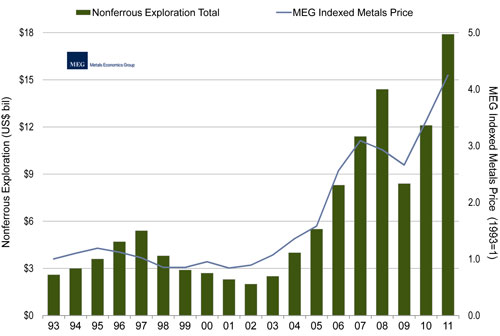
Most countries are seeing increased exploration investment in 2011, and explorers are demonstrating a higher tolerance for risk despite additional concerns and uncertainty about security, policy, and tenure in many countries. Of the 120 countries for which we documented exploration spending by the industry, those commonly perceived to be high risk account for 23% of the 2011 aggregate exploration total, up from less than 16% in 2010. The potential reward often increases the industry’s appetite for risk during periods of increased exploration spending, but exploration in high-risk countries, particularly early-stage work, is usually the first to be cut when risk levels or uncertainty increases.
The proportion of overall exploration spending dedicated to early-stage and generative work has been fairly stable over the past three years; however, at just a third of overall allocations it is historically low. The decline in grassroots’s share of spending over the past decade correlates with the upward trend in late-stage and minesite budgets, as companies spent more on late-stage projects to move them towards production or to make them attractive for acquisition, and on minesite work as a less expensive and less risky means of replacing and adding reserves. However, the number of large-scale assets advancing to development has not risen proportionately with this increased focus on late-stage projects, contributing to constraints on meaningful production increases for most metals. The apparent decline in grassroots efforts relative to late-stage and minesite exploration over the past cycle and the considerable time needed to advance a new discovery to production mean that the pool of viable, large-scale assets available for actual development is unlikely to grow in the near future.
MEG’s 2011 exploration estimate is based on information collected from almost 3,500 mining and exploration companies worldwide, of which more than 2,400 had exploration budgets in 2011. The 2,400 companies (each budgeting at least $100,000) together budgeted $16.3 billion for nonferrous exploration in 2011. Including estimates for the budgets that MEG could not obtain, the 2011 worldwide exploration budget totals $18.2 billion.
From the report entitled, “Exploration budgets up 50% – surging to new all-time high” by Metals Economics Group. Metals Economics Group (MEG) is a trusted source of global mining information and analysis. With three decades of comprehensive information and analysis, MEG has an unsurpassed level of experience and historical data. The information provided herein has been provided to MiningFeeds.com by the author and, as such, is subject to our disclaimer: CLICK HERE.
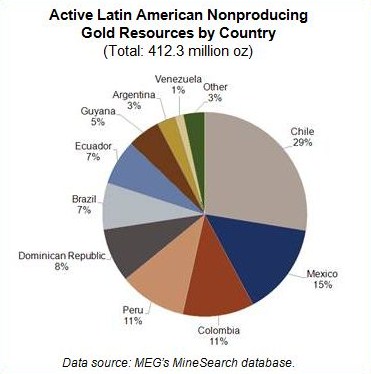
According to a recent mining industry report by Metals Economics Group (MEG), Latin American gold production should increase more than 10% in 2011. The report states that about two thirds of Latin American production is from primary gold mines and the rest is from secondary sources, mostly copper and silver mines.
Although Chile is Latin America’s fifth largest gold producer behind Peru, Mexico, Brazil, and Argentina, it holds the largest share of gold in active non-producing projects equating to 29% of gold contained in resources under development. Mexico holds the second largest non-producing gold resources and the largest producing resources holding 28% of gold contained in producing resources.
In addition to the advanced exploration projects that are progressing from reserves development to production, early-stage exploration by junior companies is contributing to the Latin American gold project pipeline. Since 2000, junior companies’ allocations to all stages of Latin American gold exploration have increased each year except three: in 2001-02 when gold prices were languishing at the $300/oz level, and in 2009 when the equity markets collapsed. The number of exploration successes (positive drill intersections and resource increases) has followed the same general trend.
From the report entitled, “Latin American Gold Output Increases in 2011” by Metals Economics Group. Metals Economics Group (MEG) is a trusted source of global mining information and analysis. With three decades of comprehensive information and analysis, MEG has an unsurpassed level of experience and historical data. The information provided herein has been provided to MiningFeeds.com by the author and, as such, is subject to our disclaimer: CLICK HERE.
Pipeline Activity Index (PAI) decreased for the second consecutive month in July, then slightly improved in August on the back of a record number of significant drill results. Both months remained below the PAI’s 2011 year-to-date average and well short of the March 2011 high, as the increased exploration activity was not enough to counteract uneasy markets that are making capital raising difficult, particularly for base metals companies.
The industry’s aggregate market cap increased slightly to $2.35 billion in July, before fears of stagnant global economic growth and a potential double-dip recession dragged market caps down to $2.19 billion in August—the lowest level since November 2010.
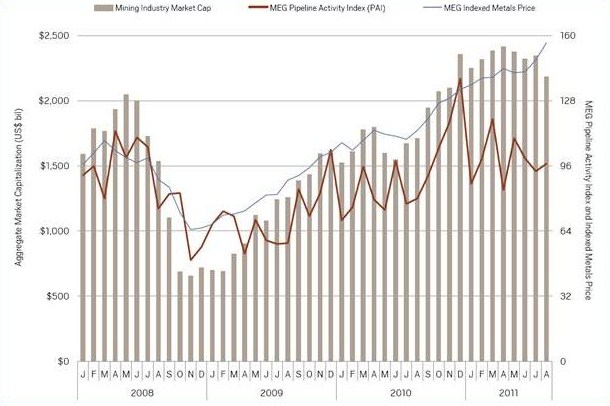
The number of significant drill results announced hit a record high in August, increasing for the fourth consecutive month. Gold explorers continue to be motivated by record-breaking bullion prices, while copper- and silver-focused exploration has helped drive the number of base metals results to their highest levels since before the 2008-09 recession. As has been the case throughout most of 2011, North America and Latin America continue to be the dominant regions for successful drilling, with Africa also contributing significantly to gold results and Australia-Pacific accounting for 25% of the base metals announcements in July and August.
The number of initial resource announcements made in July and August is the lowest two-month total since July-August 2010. This may be partly explained by seasonal factors, such as a focus on summertime exploration programs. Probe Mines’ (TSX-V: PRB) Borden Lake project in Ontario with 4.06 million oz of contained gold and Atacama Pacific Gold’s (TSX-V: ATM) Cerro Maricunga project in Chile with 3.56 million oz were the two largest initial resources announced in the period.
Significant Drill Results Announced
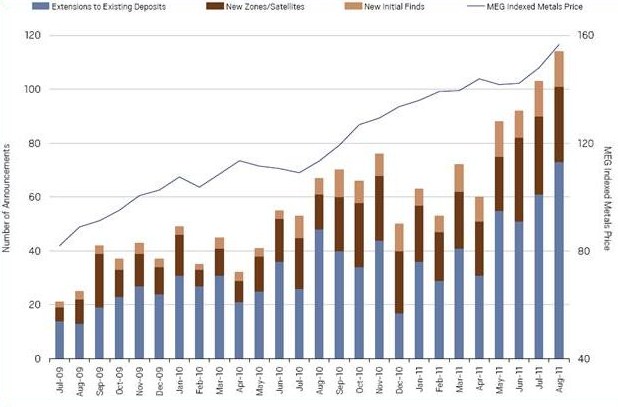
The number of significant financings (US$2 million minimum) completed remained relatively steady in July, before market tumult resulted in only 56 financings closing in August—the lowest one-month total in more than a year.
The two-month total was 10% higher than the May-June total, but included $438 million raised by Detour Gold (TSX:DGC) for development of its 20-million-oz Detour Lake gold project in Ontario. Difficult market conditions had an even stronger impact on base metals companies, as the amount raised in July-August failed to top $1 billion for the first time since January-February 2010.
The MEG Pipeline Activity Index (PAI) measures the level and direction of overall activity in the supply pipeline, incorporating significant drill results, initial resource announcements, project development milestones, and significant financings into a single comparable index. The PAI is featured in the MEG Industry Monitor—a series of comprehensive graphs and charts, with related commentary, illustrating MEG’s analysis of monthly changes and emerging trends in the base and precious metals pipeline. Using information only available from MEG through MineSearch, Exploration Activity Services, and Acquisitions Services, the Industry Monitor tracks developments based on announcements over the past 26 months of significant drill results, initial new resources, project development milestones, significant financings, and acquisitions.
From the article entitled, “Metals Economics Group Pipeline Activity Index, September 2011” by Metals Economics Group. Metals Economics Group (MEG) is a trusted source of global mining information and analysis. With three decades of comprehensive information and analysis, MEG has an unsurpassed level of experience and historical data. The information provided herein has been provided to MiningFeeds.com by the author and, as such, is subject to our disclaimer: CLICK HERE.
If you would like to receive our free newsletter via email, simply enter your email address below & click subscribe.
CONNECT WITH US
Tweets
Tweet with hash tag #miningfeeds or @miningfeeds and your tweets will be displayed across this site.
MOST ACTIVE MINING STOCKS
Daily Gainers
 New Age Exploration Limited New Age Exploration Limited |
NAE.AX | +33.33% |
        |
CASA.V | +30.00% |
    |
VKA.AX | +28.57% |
    |
CTO.AX | +25.00% |
        |
BSX.TO | +22.22% |
        |
ANK.V | +21.74% |
        |
SRI.V | +20.00% |
        |
NEV.V | +20.00% |
        |
IB.V | +18.18% |
        |
SLL.V | +16.42% |

 Follow us on Twitter
Follow us on Twitter Become our facebook fan
Become our facebook fan







